This article needs additional citations for verification .(February 2017) |

Kalis Ilustrisimo is a style of Eskrima, founded by Antonio "Tatang" Ilustrisimo.
This article needs additional citations for verification .(February 2017) |

Kalis Ilustrisimo is a style of Eskrima, founded by Antonio "Tatang" Ilustrisimo.
Kalis Ilustrisimo means "The Bladed Art of Ilustrisimo": calis (or caris) being another term for sword, blade and knife in Luzon and the Visayas, and its usage as esgrimir and esgrima (Spanish for fencing/sword fighting). This is as defined in Spanish-era Ilocano, Pampango, Tagalog, Bicolano, Ilonggo, Waray & Cebuano dictionary/vocabulary recordings dating back to 1512, [1] as the art of Tatang is more blade-oriented than stick-oriented.
The Ilustrisimo clan from Bantayan Island in the Northern part of the Cebu region, was known for their Eskrima and has practiced its own traditional stick and sword fighting style for over five generations. Its first known practitioner was Pablo Ilustrisimo who passed it on to Juan de Dios Ilustrisimo, who then passed it to the brothers Isidro, Melecio and Regino (the better known of Tatang's uncles). Tatang was mentored by his father Isidro as well as by his uncles. Another ancestor was Agapito Ilustrismo, a rebel against the Spaniards who escaped to Mount Banahaw and established a religious cult. [2]
Tatang retained his family style while he lived a long, storied, and tumultuous life and refined his fighting style from the influences of at least Pedro Cortez, a Zamboangueño bounty hunter, and a Tausug family who adopted him from age 10 to 17. He had his experiences as an eskrimador in various matches, as a seaman going around South-East Asia and as a security-enforcer for business establishments in various areas of the Philippines, including the Tondo-Binondo areas of Manila. He faced numerous duels, challenges as well as "death matches" with live blades. Family members that Tatang taught were his cousin Floro Villabrille (1912-1992) and his grandnephew Samuel Ilustrisimo.

Throughout most of his latter life, Tatang was secretive about his methods of fighting for they had kept him alive and undefeated for decades. It was only in 1976 that Tatang started openly teaching his refinement of the family style to "outsiders", with Antonio "Tony" Diego (1946-2014) and Epifanio "Yuli" Romo as his first students in Manila where he had migrated. [3] Other notable students were Christopher "Topher" Ricketts (1955–2010), Romeo "Romy" Macapagal, Pedro Reyes, Edgar Sulite (1957-1997), Rey Galang, Norman Suanico, Inocencio "Sioc" Glaraga (deceased 2021), Roberto Morales (deceased 2010), Mark V. Wiley and Ernesto Talag. Prior to World War II, Tatang had also privately taught a contemporary, Timoteo Maranga (later on Major Maranga of the Cebu police force).
Even at his advanced age, Tatang retained the respect accorded him as a fighter in the tough streets of Tondo where he resided. As a testament to his reputation, archive footage of Ilustrisimo taken well into his 80s show his speed, control, timing and accuracy with sticks, blades as well as empty hand disarms against live blades in spite of his failing eyesight.
After Tatang Ilustrisimo's death in 1997, Tony Diego was elected the head of Kalis Ilustrisimo. Tony Diego later added a descriptive to the system which became known as Kalis Ilustrisimo Repeticion Orihinal. This was on the suggestion of the late Pedro Reyes—that the senior students of Tatang should set up their own schools. Thus, there were Bakbakan Kali Ilustrisimo by Rey Galang, "Kali Ilustrisimo" by Topher Ricketts, Tagpas Kalis Ilustrisimo by Romy Macapagal, Luneta Kali Ilustrisimo by Pedro Reyes and Samuel Ilustrisimo and Olistrisimo Eskrima by Roberto Morales. Romy Macapagal, as archivist of the Kalis Ilustrisimo system and not founding a school, dropped “Tagpas” and retained Kalis Ilustrismo. Romy Macapagal went on to archive the whole system on a historic project with The Immersion Labs Foundation.
Diego had named Tom Dy Tang as successor of Kalis Ilustrismo twelve years prior to his death (2002). Diego died on August 25, 2014. Peachie Baron teaches Diego’s “Punta y Daga” style. Arnold Narzo was appointed as Kalis Ilustrisimo Repeticion Orihinal Chief Instructor by GM Diego two years (2012) before his death (2014). [4]

Arnis, also known as kali or eskrima/escrima, is the national martial art of the Philippines. These three terms are, sometimes, interchangeable in referring to traditional martial arts of the Philippines, which emphasize weapon-based fighting with sticks, knives, bladed weapons, and various improvised weapons, as well as "open hand" techniques without weapons.
Lakandula was the title of the last lakan or paramount ruler of pre-colonial Tondo when the Spaniards first conquered the lands of the Pasig River delta in the Philippines in the 1570s.
Doce Pares is a Filipino martial art and a form of Arnis, Kali and Eskrima, that focuses primarily on stick fighting, knife fighting and hand-to-hand combat but also covers grappling and other weapons as well. In reality, the stick is merely considered an extension of the hand, and is meant to represent almost any weapon, from sticks to swords to knives to anything else you can place in your hand and use as a weapon in the modern context. Doce Pares was founded in 1932.
San Miguel Eskrima is one of the major systems of eskrima, a martial arts from the Philippines. Founded by Filemon "Momoy" Cañete of the Doce Pares Club, SME served as vehicle for his own personal expression of the art and methodology of the club of which he was a co-founder and instructor. The name San Miguel is taken from Michael (archangel), the slayer of Satan, and is one of the major strikes used in Eskrima.

Balintawak Eskrima or Balintawak Arnis is a Filipino martial art created by Grandmaster Venancio "Anciong" Bacon in the 1950s to enhance and preserve the combative nature of arnis which he felt was being watered down by other styles of Philippine martial arts. It is named after a small street in Cebu where it was founded.

Edgar Sulite was a teacher of Filipino martial arts. He was the creator of Lameco Eskrima and trained such notables as Dan Inosanto, Ron Balicki, Larry Hartsell, Fred Degerberg, and Diana Lee Inosanto.

Lameco Eskrima is the system of Filipino martial arts founded by Edgar Sulite based on his training and experience with various Philippine Martial Arts masters, with heavy influence from Jose Caballero and Antonio Ilustrisimo.
Antonio "Tatang" Ilustrisimo was the Grandmaster of Kalis Ilustrisimo (KI), a Filipino martial art bearing his family name.
Bakbakan International is a martial arts association headquartered in Manila, Philippines and founded by Christopher Ricketts. It has chapters in Australia, Canada, and the United States. It also promoted the Masters of Arnis tour in Australia that featured Christopher Ricketts, Antonio Diego, Edgar Sulite, and Rey Galang.

Sibat is the Filipino word for spear, used as a weapon or tool by natives of the Philippines. The term is used in Tagalog and Kinaray-a. It also called bangkaw, sumbling or palupad in the islands of Visayas and Mindanao; and budjak among Muslim Filipinos in western Mindanao and the Sulu Archipelago.
De Campo Uno-Dos-Tres Orihinal is a form of Filipino martial arts. The majority of its techniques are based on fighting with a single stick as opposed to the double stick method used in most Filipino martial arts.
Reynaldo S. "Rey" Galang is a Filipino martial arts teacher and author. He is one of the chief founders and head instructors of Bakbakan International.
Christopher Naldo Ricketts was a well-known Filipino martial arts innovator, teacher, actor and author. He was also one of the chief founders and head instructors of Bakbakan International and the eldest brother of the action star Ronnie Ricketts.
Ciriaco "Cacoy" Cañete was a Filipino martial artist of the Doce Pares Eskrima Club. He was the last surviving member of the club, which was founded in January 1932. He was also a 12th degree black belt. His version of the Doce Pares Eskrima system is known as Cacoy Doce Pares. In 1951 he developed a personal system of his named Eskrido.
An abaniko is a type of hand fan from the Philippines.
Arnis in popular culture reflects the impact that the Filipino martial arts of arnis/eskrima/kali have made outside of the martial arts community. The three terms are roughly interchangeable and for the purpose of convenience, the term arnis will be used throughout the article. These arts emphasize weapon-based fighting with sticks, blades, improvised weapons and hand-to-hand fighting which is formally known as Mano Mano or Pangamut. Because of this training with live weapons, elements of arnis have made an impact in film, video games, television, and comic books. Arnis is often used to train actors and stuntmen how to handle similar weapons for use in movies.
Ronald Naldo Ricketts, popularly known as Ronnie Ricketts, is a Filipino actor, scriptwriter, film director, line producer, and martial artist who is the former president of the Philippine Film Actors Guild, and former chairman of Optical Media Board (OMB), a government agency that regulates recording optical media in the Philippines.

Suntukan is the fist-related striking component of Filipino martial arts. In the central Philippine island region of Visayas, it is known as Pangamot or Pakamot and Sumbagay. It is also known as Mano-mano and often referred to in Western martial arts circles of Inosanto lineage as Panantukan. Although it is also called Filipino Boxing, this article pertains to the Filipino martial art and should not be confused with the Western sport of boxing as practiced in the Philippines.

The baston is one of the primary weapons of Arnis and Filipino martial arts. It is also known as yantok, olisi, palo, pamalo, garrote, caña, cane, arnis stick, eskrima stick or simply, stick.